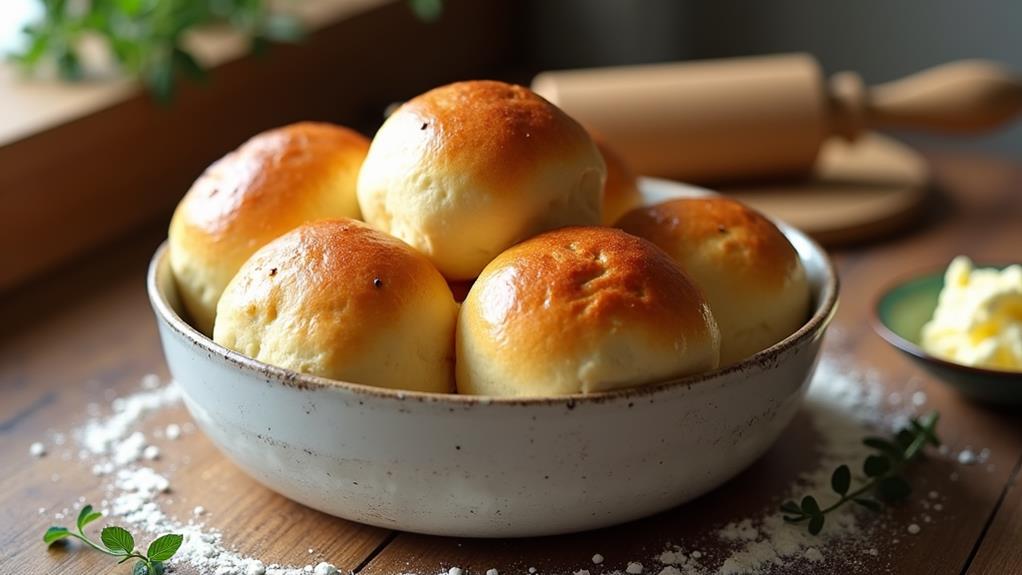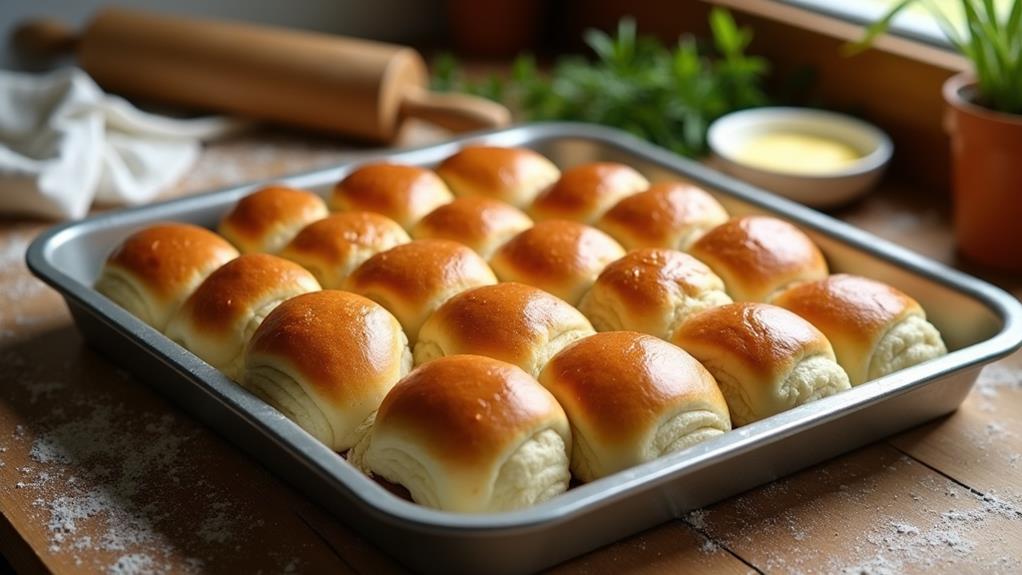Imagine walking into a cozy kitchen where the aroma of freshly baked bread lingers like a warm hug. That's the experience Parker House Rolls offer, with their soft, buttery layers inviting you to savor each bite. Originating from a historic Boston hotel, these rolls have become synonymous with gatherings, but what makes them truly special? As you explore their origins and the simple recipe behind their charm, you might discover more than just a side dish; you could find a connection to tradition and comfort that's worth exploring further.
History
The history of Parker House rolls dates back to the 19th century at the renowned Parker House Hotel in Boston. You might be surprised to learn that these delicious rolls were created by a talented baker who aimed to impress guests with something truly special. Known for their soft, buttery texture and slightly sweet flavor, Parker House rolls quickly became a beloved staple in this famous Boston bakery.
As you gather with friends and family, you can appreciate how these rolls represent more than just food; they embody the culinary traditions that connect people. Imagine serving warm, golden rolls fresh from the oven, filling your home with a delightful aroma. Guests can't help but smile as they break apart the fluffy dough, ready to slather on butter or enjoy them with a hearty meal.
The story of Parker House rolls is a tribute to the joy of sharing food with others, and it's a reminder of the rich history behind beloved recipes. By serving these rolls, you're not just offering a treat; you're sharing a piece of Boston's culinary heritage, inviting everyone to savor a delicious connection to the past.
Recipe

Parker House Rolls are a classic American bread that originated in Boston at the Parker House Hotel in the 1870s. These soft, buttery rolls are known for their distinctive folded shape and flaky texture, making them a perfect accompaniment to any meal. Their slightly sweet flavor and airy crumb make them ideal for soaking up gravy or enjoying with a spread of butter.
Making Parker House Rolls at home may seem intimidating, but with a little patience and the right ingredients, you can achieve that melt-in-your-mouth quality that has made these rolls a beloved staple. The process involves creating a rich dough that's allowed to rise, shaped into rolls, and then baked to golden perfection. Whether served at a holiday dinner or a casual family gathering, these rolls are sure to impress.
Ingredients:
- 1 cup whole milk
- 1/2 cup granulated sugar
- 1/2 cup unsalted butter
- 2 1/4 teaspoons active dry yeast (1 packet)
- 4 cups all-purpose flour
- 1 teaspoon salt
- 2 large eggs, beaten
- Extra melted butter for brushing
Cooking Instructions:
In a small saucepan, heat the milk until warm (about 110°F), then stir in the sugar and butter until melted. Remove from heat and let cool slightly before adding the yeast, allowing it to bubble for about 5 minutes.
In a large mixing bowl, combine the flour and salt, then add the yeast mixture and beaten eggs. Mix until a dough forms, then knead on a floured surface for about 5-7 minutes until smooth.
Place the dough in a greased bowl, cover with a kitchen towel, and let it rise in a warm place for 1-2 hours or until doubled in size. Once risen, punch down the dough and divide it into 12 equal pieces.
Shape each piece into a ball and fold it in half, placing it seam side down in a greased 9×13 inch baking dish. Let the rolls rise again for about 30 minutes.
Preheat your oven to 375°F and bake for 20-25 minutes until golden brown. Brush with melted butter before serving.
Extra Tips:
For best results, make sure that your yeast is fresh and active; if the milk is too hot, it can kill the yeast, so aim for just warm to the touch.
If you wish to prepare the dough in advance, you can refrigerate it after the first rise and shape the rolls the next day. Additionally, feel free to experiment by adding herbs or cheese to the dough for a unique twist on the classic recipe.
Similar dishes include dinner rolls, soft brioche rolls, and crescent rolls, each offering its own unique flavors and textures while often using similar basic ingredients like flour, yeast, and butter.
Final Notes
Achieving the perfect Parker House Rolls is as much about technique as it's about using quality ingredients. You'll want to focus on kneading the dough just enough so it's smooth but not overworked.
Remember, resting the dough is key; it allows the yeast to work its magic, creating those light, fluffy rolls everyone loves.
When you've baked your rolls to golden perfection, think about how you'll serve them. A warm basket lined with a soft cloth not only keeps the rolls warm but adds a lovely touch to your table.
You might even consider adding a small dish of honey butter or herb-infused olive oil for dipping—trust me, your guests will appreciate it!
For those seeking baking tips, don't shy away from experimenting. Try adding garlic powder or herbs to the dough for an extra layer of flavor.
And if you have leftovers, they freeze beautifully! Just wrap them tightly before popping them in the freezer.
With these final notes, you're ready to impress your family and friends. Enjoy every moment of sharing these delightful rolls with those you love!

